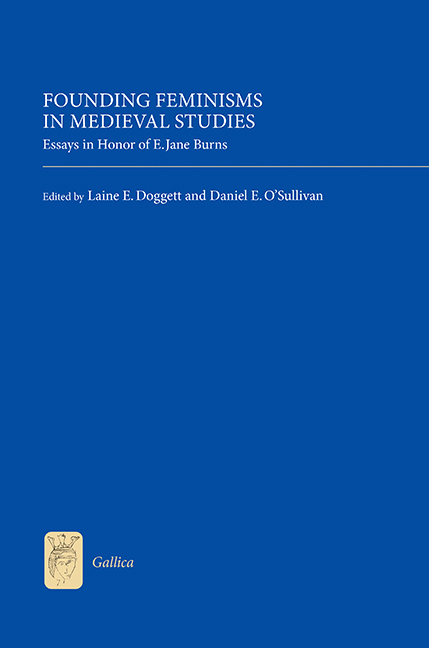Book contents
- Frontmatter
- Contents
- List of Illustrations
- List of Contributors
- Acknowledgements
- Introduction: The Work of E. Jane Burns and the Feminisms of Medieval Studies
- E. Jane Burns: A Bibliography
- Part I Debating Gender
- Part II Sartorial Bodies
- Hats and Veils: There's No Such Thing as Freedom of Choice, And It's a Good Thing Too
- When the Knight Undresses, his Clothing Speaks: Vestimentary Allegories in the Works of Baudouin de Condé (c. 1240–1280)
- John/Eleanor Rykener Revisited
- Part III Mapping Margins
- Part IV Female Authority: Networks and Influence
- Afterword: A Response to the Volume
- Index
- Tabula Gratulatoria
- Already Published
John/Eleanor Rykener Revisited
from Part II - Sartorial Bodies
Published online by Cambridge University Press: 05 July 2016
- Frontmatter
- Contents
- List of Illustrations
- List of Contributors
- Acknowledgements
- Introduction: The Work of E. Jane Burns and the Feminisms of Medieval Studies
- E. Jane Burns: A Bibliography
- Part I Debating Gender
- Part II Sartorial Bodies
- Hats and Veils: There's No Such Thing as Freedom of Choice, And It's a Good Thing Too
- When the Knight Undresses, his Clothing Speaks: Vestimentary Allegories in the Works of Baudouin de Condé (c. 1240–1280)
- John/Eleanor Rykener Revisited
- Part III Mapping Margins
- Part IV Female Authority: Networks and Influence
- Afterword: A Response to the Volume
- Index
- Tabula Gratulatoria
- Already Published
Summary
As we sat together at the karonkka (banquet) following Tom Linkinen's 2013 Ph.D. defense, at which Ruth Karras had been the opponent (outside examiner), the two of us discussed John/Eleanor Rykener, the cross-dressing prostitute from late medieval London about whom Karras and David Boyd had written in the 1990s. Karras noted that if she were to write those articles over again she would suggest that we might understand Rykener as a transgender person rather than as “transvestite,” the term used in that article. Because it is very difficult to know anything about Rykener's own feelings on the topic from the medieval evidence – a brief account of Rykener's arrest and confession to various sexual acts, found in London court rolls – she had thought of making the case via fiction. However, with no experience in writing fiction, she had found the process very difficult and returned to the archives, where she felt more comfortable. Linkinen told her that he agreed about Rykener as transgender and had written a conference paper to that effect. After dinner, the attendees were ushered into a small theater in which, to Karras's astonishment, Linkinen and others performed a puppet show entitled “John-Eleanor,” which opened up precisely this possibility. This show, which had been performed at the Turku Festival in 2012 and subsequently elsewhere in Europe, powerfully demonstrated to a contemporary audience the uses of imagination in the study of history. This work, together with the novel A Burnable Book by Bruce Holsinger (2014), which makes use of the same case, indicate the hold that clothing as a signifier of gender binaries has on that imagination. These two works – which can be considered works of scholarship presented in fictional form – make the argument that it is clothes that make the medieval woman or man. In the absence of subjective indicators of medieval identities, modern scholars can rely on records of outward behavior and markers, and clothing is most prominent among these. Following the lead of Judith Bennett's work on lesbianism in the Middle Ages, we can say that even if we do not know anything about Rykener's self-identification, hir life as a male-bodied woman was “transgender-like.”
- Type
- Chapter
- Information
- Founding Feminisms in Medieval StudiesEssays in Honor of E. Jane Burns, pp. 111 - 122Publisher: Boydell & BrewerPrint publication year: 2016



